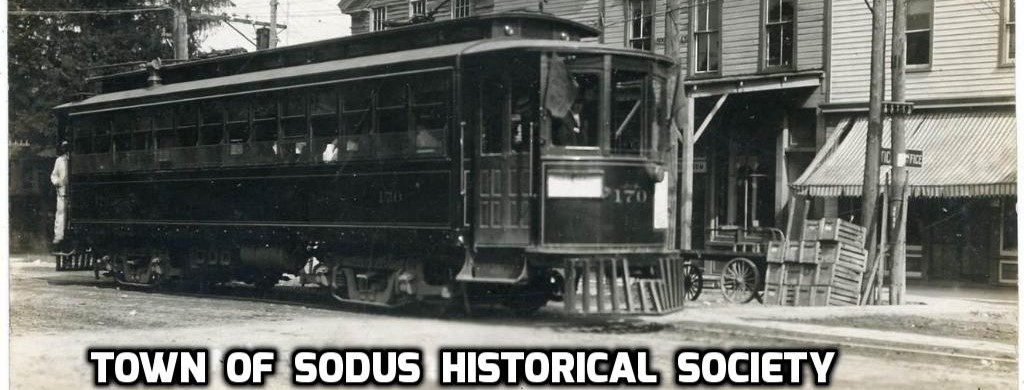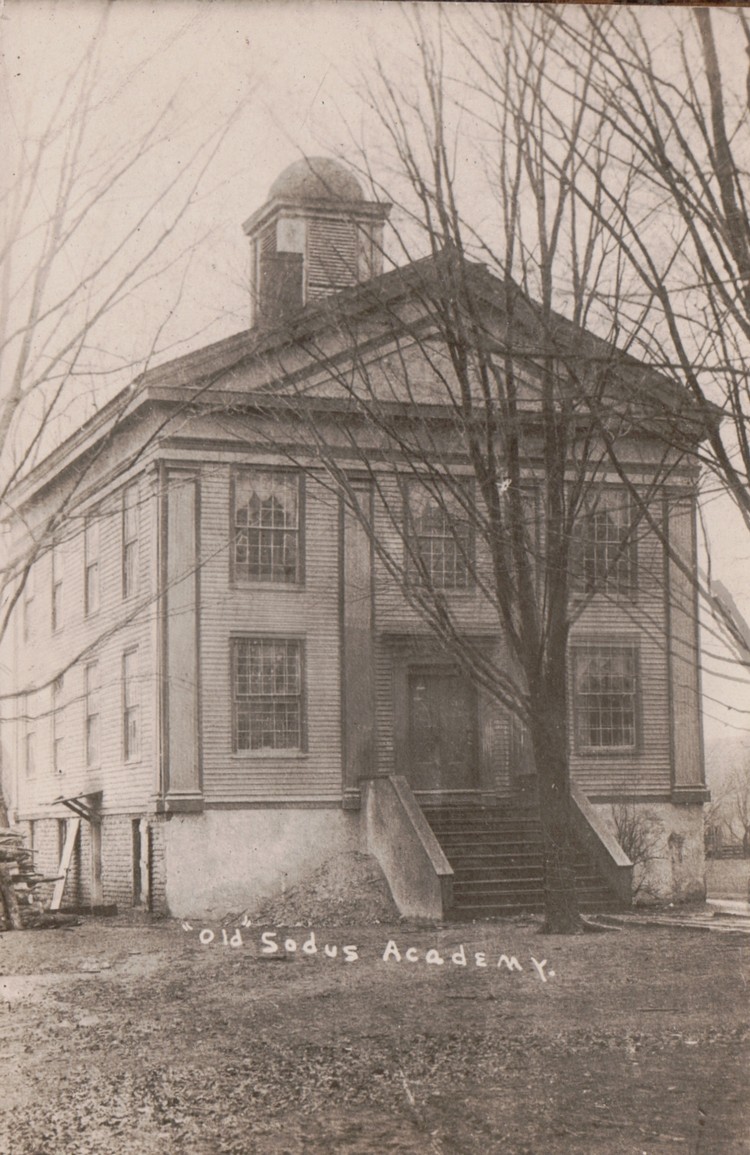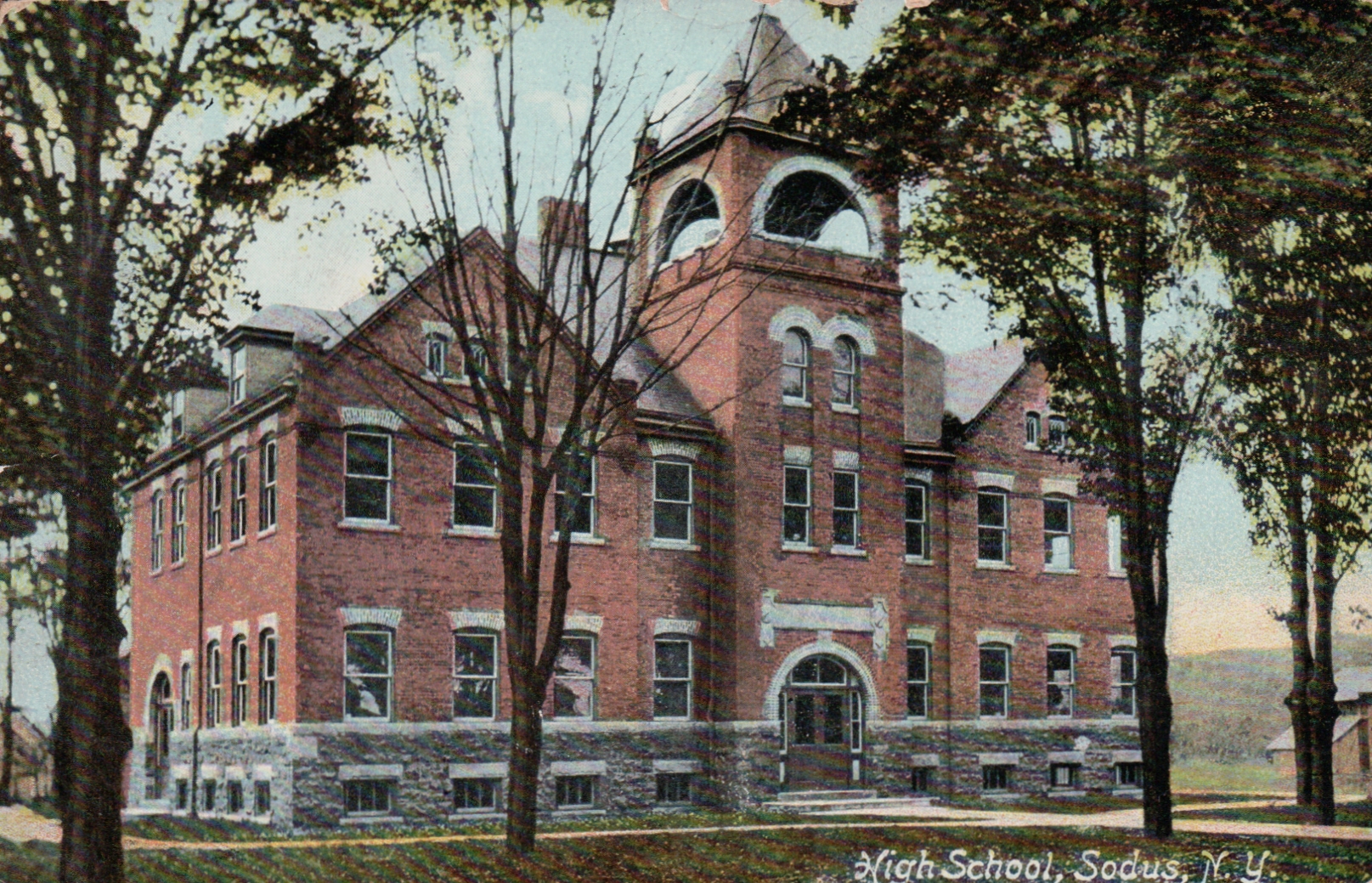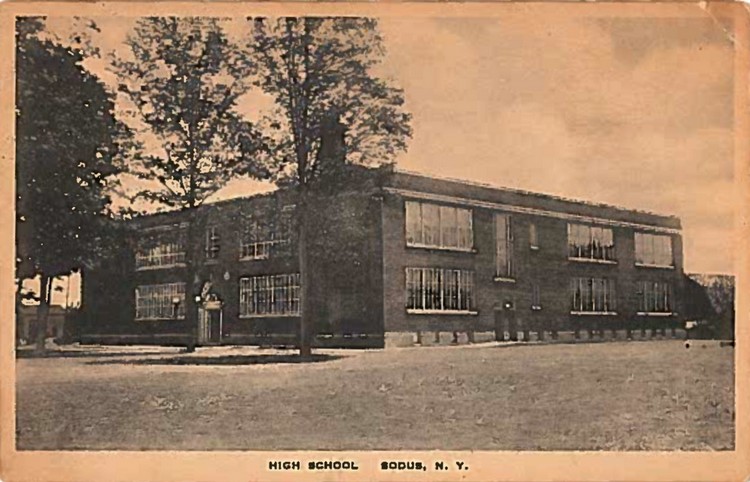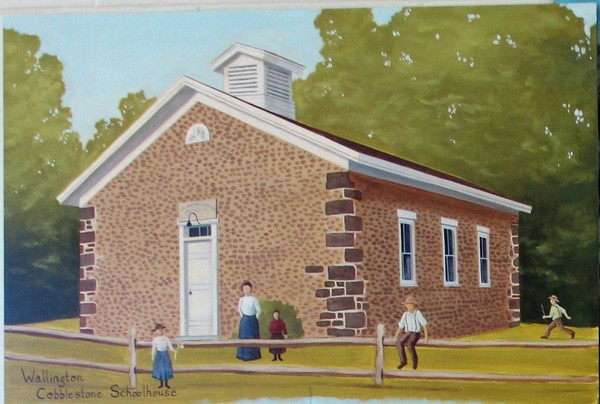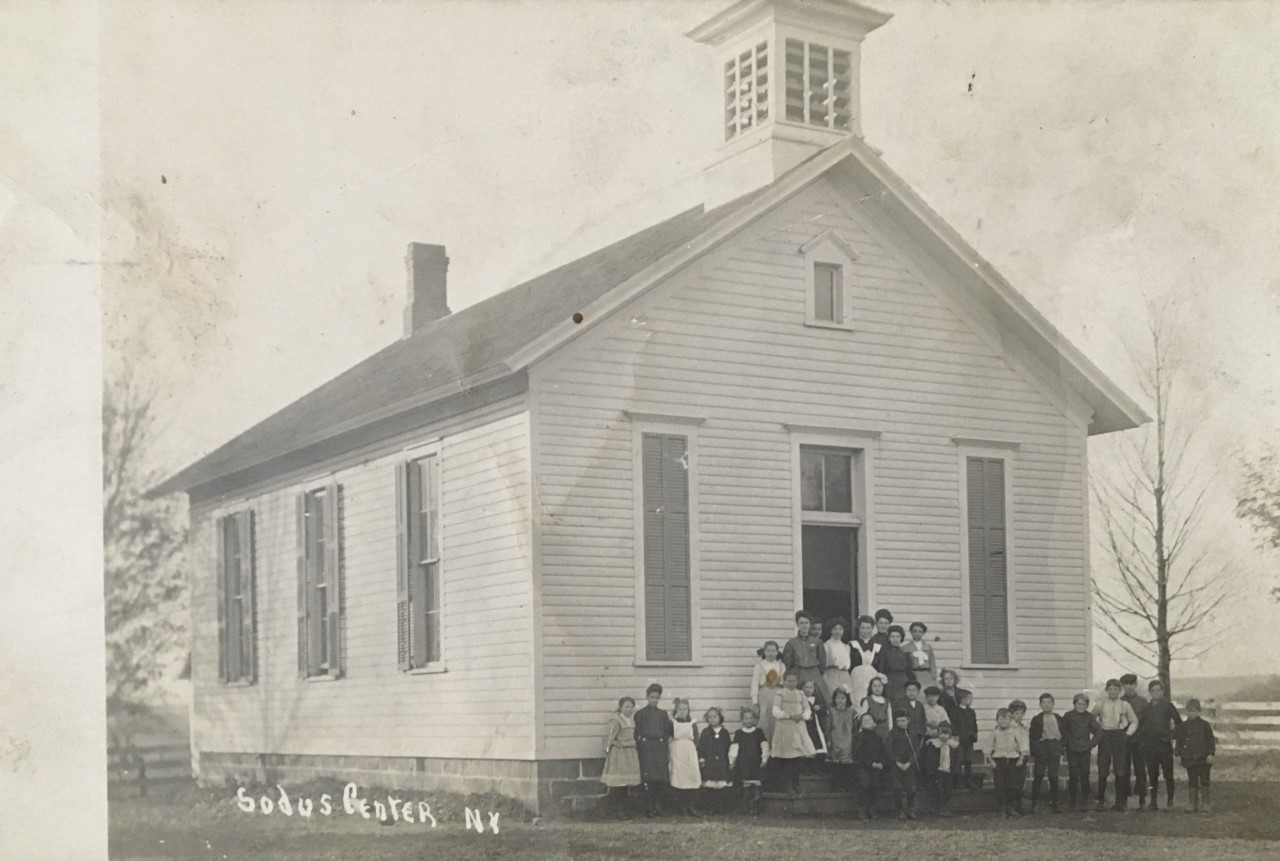
The above photo and information below are taken from the 1951 Sodus High School Dedication Ceremony courtesy of Bette Bugni
History of Education in the Township of Sodus
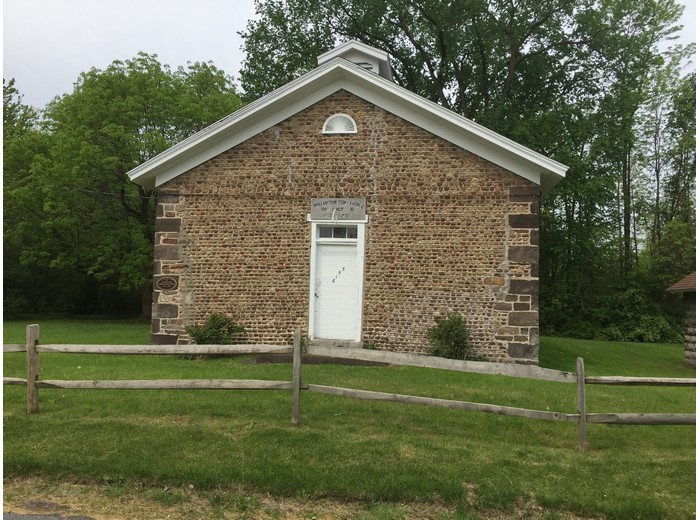 Photo of Wallington Cobblestone School courtesy Edith Farrington
Photo of Wallington Cobblestone School courtesy Edith Farrington
It is probable that the first school in the town of Sodus was on the Geneva Road, north of Wallington, then known as “Arms Crossroads”. In the year 1808 or 1809 taught by Mrs. Armsbury, sister of Daniel Arms, but we are not told whether there was any school building or whether, as was often the case in those days, classes were taught in a home. Soon after that, a schoolhouse was built on the Lake Road across from what is now Sprong farm, but it was not used for any length of time. Elder Seba Norton, pastor and builder of Brick Church at Sodus Center, built a house intended for a school probably near the intersection of Maple and Lake Roads, but history does not indicate whether this building was ever used. For a time, there was a schoolhouse at the forks of the Lyons road, known as “Merchants”. A schoolhouse was erected at Sodus Center in 1812, on a site located approximately in front of what is now the east wing of the Sodus Hotel Building.
In 1812, the State Legislature passed a law authorizing the towns of the state to be divided into school districts by three school commissioners, and each district was to elect 3 trustees to take care of its schools and share of money. Accordingly, in 1813, at the third annual town meeting, at the home of Daniel Arms, the first formal action of the town of Sodus in relation to schools was taken. It was voted that the town comply with provisions of the law, and therefore they chose three commissioners – John Holcomb, Byram Green, and William Wickham. Also, six school inspectors were appointed at that time – Enoch Morse, Thaddeus Bancroft, William N. Lummis, William Danforth, Daniel Arms, and Peter Failing.
The October 9, 1889 Wayne Alliance (page 3) ran an article about that meeting in April 1813:

In June of that year, the commissioners made out the first legal list of school districts – eleven in number. No. 1 , Sodus Point and vicinity. No. 2, next west, No. 3, beyond extending to the west line of the old Henry Ward Farm. No. 4, Sodus Village. No. 5, along the Ridge, west. No. 6, north of 5, extending through to the lake west of No. 3. No. 7, all the southwest part of the town. No. 8, Arms Crossroads (now Wallington). No. 9, Sodus Center, extending far to the west and south. No. 10, South Sodus, extending north to the present Stell Road. No. 11, all of the rest of Gore along the east part of the town in the south bounds of district No. 1, at Sodus Point. Later on, the number of districts was increased to 23, but eventually reduced to 21, by redistricting.
The Legislature of 1849 passed a bill making all the common schools of the state “free”; but this was repealed in April, 1851 and the “rate-bill system” was reinstated. During the 1853 session, a law was passed allowing Union Free Schools to be established under certain conditions; and in March, 1854, the office of Superintendent of Public Instruction was created, improving the system of education over the situation which existed while the School Department was a subordinate branch of the Department of State, as it had been for some years. In April, 1855, a law was passed allowing the Regents of the University of the State of New York to designate certain Academics of the several counties in which a teachers’ class might be taught free- the State allowing $10. per pupil so taught to a number not exceeding twenty in each academy.
Old Sodus Academy photo courtesy of Bette Bugni
However, the people of Sodus, prior to the academy law passed by the State, considered founding an academy in Sodus and held their first meeting February 3, 1852, and the resolutions providing for the formation of an academy association were adopted February 28, 1852. The first trustees were: Michael O’Keefe, Jerry C. Rogers, John White, Miles L. Landon, Dennis Lefurgey, Jesse H. Green, Anson Proseus, Lewis H. Clark, William Sergeant, Enoch Granger, Silas P. Hulett and Andrew C. Williams. The site for the proposed institution, on the lot on the south side of Ridge Road near the westerly end of Sodus Village and between what are now Carlton Street and Elmwood Avenue, was chosen April 30, 1852, and was purchased from Silas P. Hulett. The erection of the building was delayed until the summer of 1853. It was finally completed on the 18th day of October that year. In the autumn of 1854, the sum for the necessary library and equipment was raised, and the Board of Regents incorporated it as an endowment academy January 11, 1855. In the winter of 1858-1859, a subscription of $800. was obtained to meet the liabilities of the institution.
The Sodus Academy continued in existence until 1902. During this time, a two-room public school located on School Street, which was a grade school only, and was known as the “District School”, was operated by Sodus District No. 4. This was the only free school in the Village, a charge for tuition being made at Sodus Academy. In 1901, it was decided that there should be a free school for both grade and high school students operated by the district.
The brick Sodus High School photo courtesy of Bette Bugni
The School Street School and the Academy were discontinued and in 1902, a new brick building was built by District No. 4 on the site of the Sodus Academy building. The Academy was a two-story frame building standing on a high wall farther back from the street and was used by the district during the time that the 1902 brick building was under construction. The large hand-hewn beams from the old Sodus Academy Building are in the Furniture Store and Funeral Home Building now owned by H. S. Norton.
By 1918, the school had become overcrowded and from the fall of 1919 through the spring of 1922, the first and second grades were housed in what is now the Community House. In June 1922, the District purchased the lot at the corner of Elmwood Avenue and West Main Street, and in October 1922, the District purchased the lot at the corner of Carlton and West Main Streets on which stood a frame house. This house was used for the first and second grades for three years.
Sodus High School 1925 – 1950. Later the building would become Dynalec. Photo courtesy Bette Bugni.

1924 photo of children attending public school at the Presbyterian Church. Photo courtesy of Dana Bishop Michelsen. Dana’s grandmother was Dorothy DuBois (DeNeef) and she is just below/ in front of the teacher.
In 1925 the school building was partially razed, remodeled, and greatly enlarged. During this process, from April 1914 to September 1925, all of the grade and high school pupils were housed in the Presbyterian and Methodist Churches. The resulting structure was first occupied in the fall of 1925 and continued in use until the fall of 1950, housing all of the grades and high school except for the school years beginning in the fall of 1944 when the kindergarten, first and part of the second, grades were housed in the basement of the Presbyterian church.
In 1925 the State Legislature passed a Central School Law which permitted common school districts and/or Union Free Districts to combine in order to provide for better educational opportunity through increased facilities. Many of the various Towns in Wayne County took advantage of the Central School Law and centralized during the 1930s. Under District Superintendent Lewis H. Clark, and John A. DePoint, President of the Board of Education of Sodus High, an attempt was made to centralize school districts in Sodus in 1938, but little interest was shown on the part of the people at that time.
In the fall of 1943 District Superintendent F. S. Hungerford organized a lay committee in Sodus composed of the following people: Marcus Buckman, Morris Buerman, Edward E. Burns, Morris Butts, Eugene Cook, Harold Dye, Mrs. Murray Featherly, Martin Foss, Granger Green, Norman R. Kelley, Dr. F. Linwood Myers, Roy Palmer and Claude Yeomans. Information and data concerning the proposed Sodus Central School was presented to voters at School District meetings during the winter of 1943-44. On June 14, 1944 a centralization vote was held in the high school building at Sodus, and Sodus Central School District No. 1 became a reality by a vote of 540 to 62. All of the districts in the township became part of centralization with the exceptions of Nos. 10, 16, 21 and a portion of 17. The members elected to the original Board of Education were: Dr. F. L. Myers, Eugene Cook, Edward Hoste, Edward Burns, and Morris Butts. Immediately plans were made to construct a school building to house all of the pupils in the new central district. On July 23, 1948 bonds were approved at a district meeting; and, with the official approval of State Education Department through the office of District Superintendent Morris J. Livingston, the new building was started in August 1948. The cornerstone-laying ceremonies were held May 27, 1949, and in September 1950, the kindergarten and first six grades occupied the building for the first time, but the upper six grades were unable to move in until Thanksgiving time. The realization of a long-awaited educational milestone in the township was celebrated at the formal dedication ceremony January 26, 1951.
To the many schools which have come and gone, to the forward- looking people who through the years have given their support, to the teachers, trustees, and school board members who have managed and developed our schools, and lastly, to the progressive idealism, conscientious work, faithful efforts, and sacrifices of all – this building is indeed a true memorial.
As stated above, with the centralization of Town of Sodus schools into the high school and grade schools into Sodus, 1950 saw the end of the remaining one and two room schools outside of the village of Sodus. We would like to pay tribute to some of them as a reminder of what was given up and what used to be…
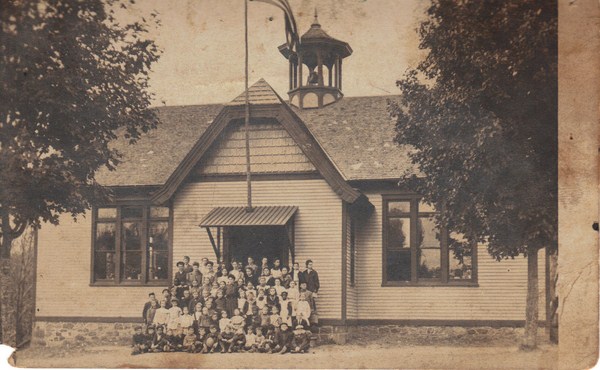
Sodus Point two room schoolhouse nowadays used as their Community Center. Photo courtesy Ruth Carter

Above. 1938 Photo of the Salt Works School located just north of Sodus Point on RT. 14. now used as a boat museum. Photo courtesy of Ron Bill.
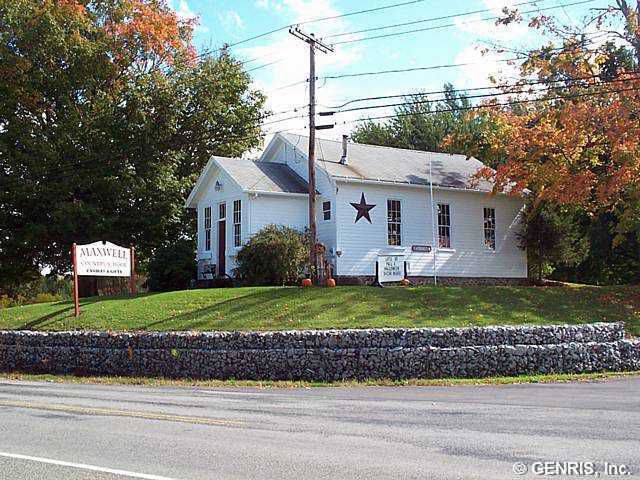
Above. Maxwell/Sentell School just west of Sodus Point. We believe this school was the first in the area that had both white and black children in attendance in the mid 18oos. Left to Right: Back row: Wm. Sentell, Bernice Shirtz, Jennie Sentell, Myron Proseus (teacher), Clara Drake, Minnie Shirtz, George Pultz, Leon Shirtz. Middle row: ? Webb, Charles Shirtz, Jay Baldwin, Frank VanDuser, Stella Shirtz, Mabel Baldwin, Flora Fleming. Bottom row: Arthur Fleming, ? Bennett, Glen Halcus, Walt Reed, Roy Mason, Ross Sergeant. Circa 1886. This school now used as a gift shop. Photos courtesy of Bette Bugni and Edith Farrington
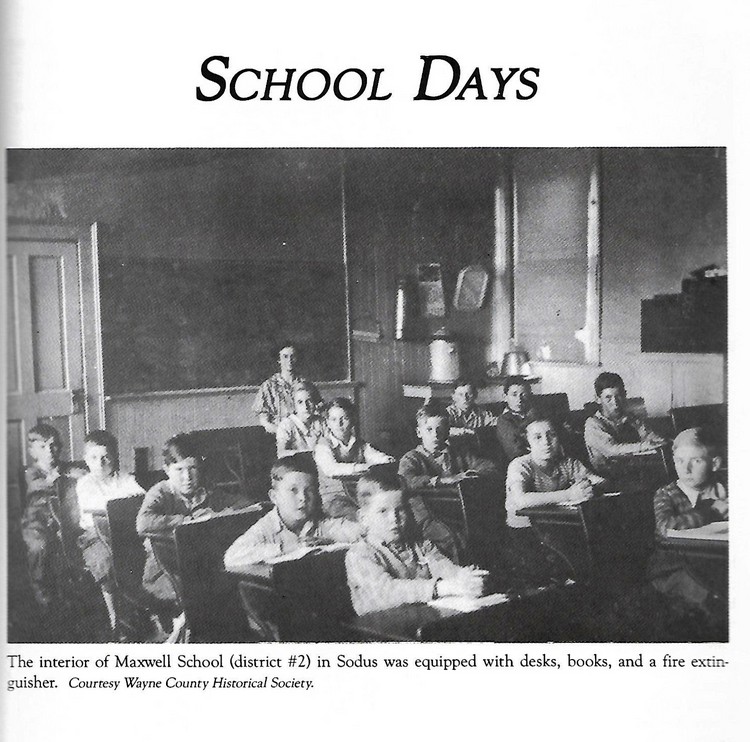
Another photo (above) of Maxwell/Sentell School Nov. 10, 1935. Aisle 1 (starting at the back) Lloyd Odell, Gerald Harnett, Bruce Brice, Ralph Odell, Richard Sergeant. Aisle 2 (back to front) Teacher Ila Seager, Lucille Balch, Doug Sergeant, Mike Fletcher, Betty Pearsal, Stuart Balch. Aisle 3 (back to front) George Fletcher, Fred Sergeant, Harry Ternoois. Names from Leo Fletcher 2/25/96. Photo courtesy of Remembering Wayne by Andrea Evangelist.
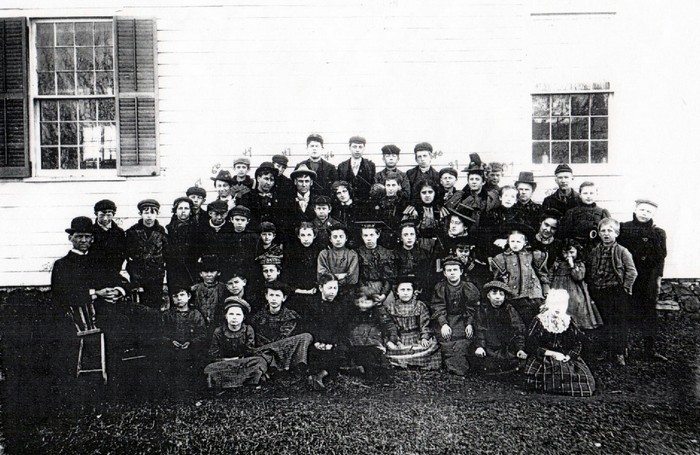
South Sodus School in the 1890s. Photo courtesy of Margaret Merhoff

Joy Schoolhouse nowadays used as a community center. Painting from the Town of Sodus mural.
Wallington Cobblestone Schoolhouse. First schoolhouse in the Town Of Sodus. Now run as a museum and a few times a years, it has 4th graders attend to learn what it was like to attend a one room schoolhouse. Painting from the Town of Sodus mural.
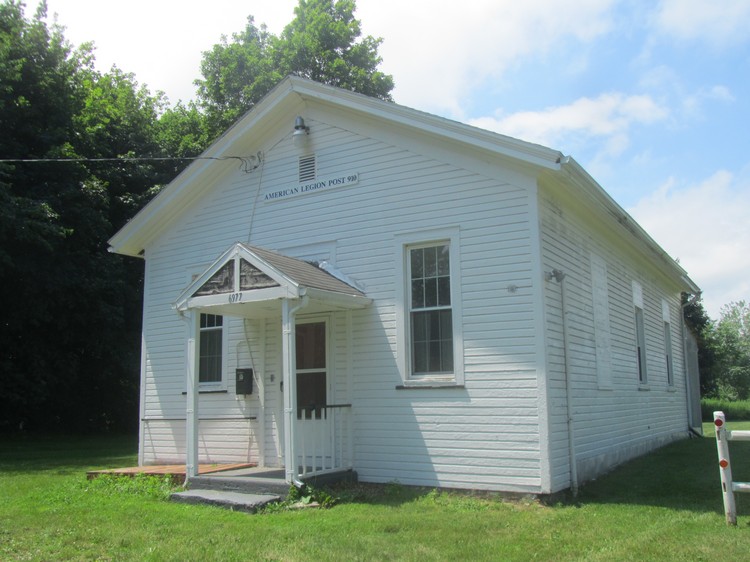
One room schoolhouse located on Maple Avenue just north of Sodus. Nowadays used as an American Legion Post. This was the District #14 School also known as the Granger School. Photo courtesy of Edith Farrington
Granger District #14 – 1935
Photo and information courtesy of Hazel Heald Wahl


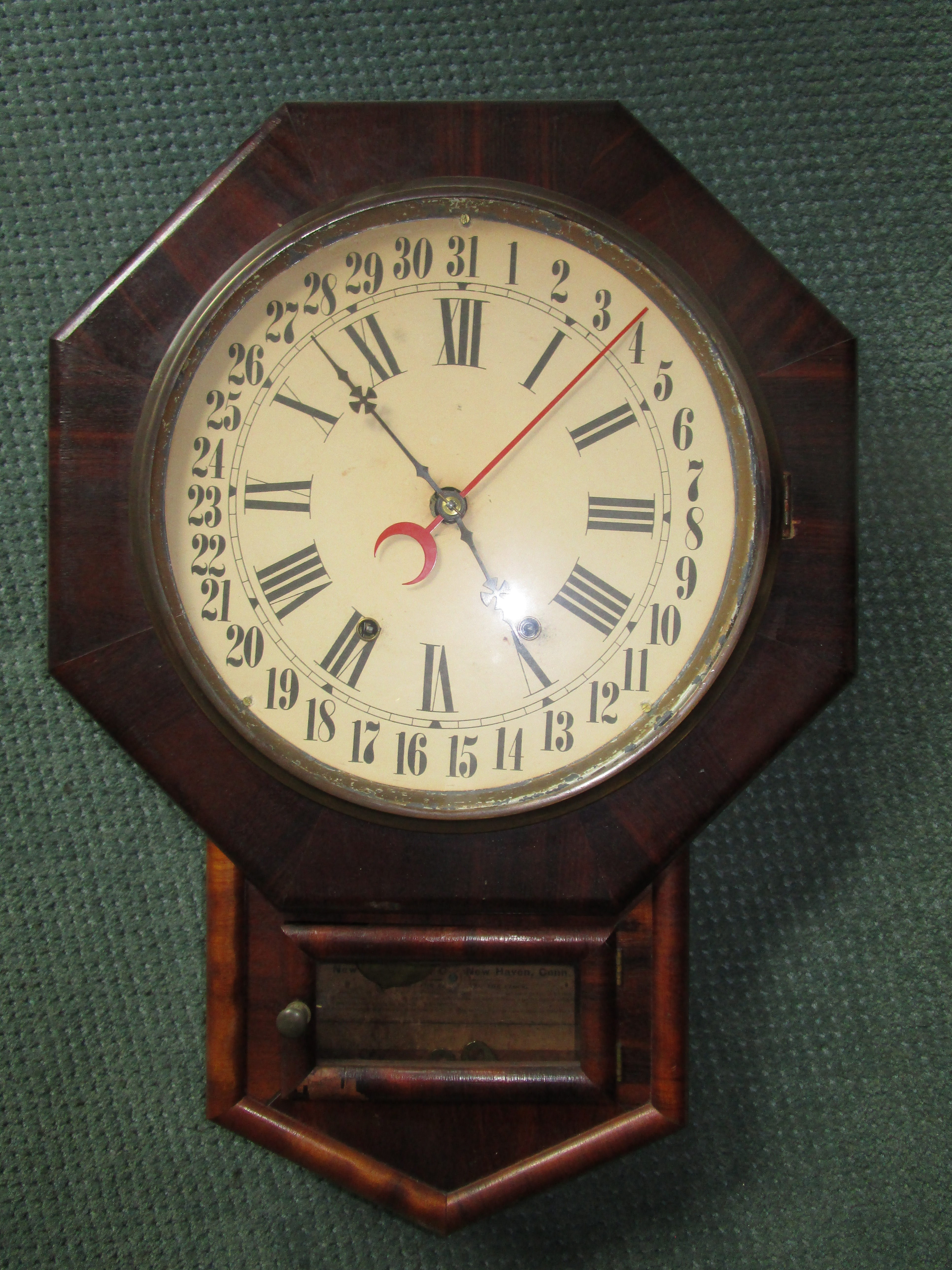
This beautiful, historic clock once hung on the wall at the Granger Schoolhouse, Dist. #14 . It has been donated by Sandra Hamilton & is now at the Sodus Community Library.
District #6 (Centenary) Photo courtesy of Bette Bugni

From an interview with Ralph Toor in 1992 on his experiences going to a one room school at Centenary. From Old Tales I, II and III pages 4-5 by Ralph V. Toor
The One-Room School
I recall the overpowering smell of chalk when I first entered our one-room schoolhouse in 1903. There may have been a combination of odors but to me it was chalk. Does chalk still smell?
Our school was District No. 6, Town of Sodus, Wayne Co., N .Y. and was on the northwest comer of Middle and Centenary roads. Twenty-five feet west was the Centenary church and church sheds.
Inside the school there were five double seats on each side and three triple seats in the center. In front of them was the stove. At the right of the door was the blackboard made of two wide boards in a frame and painted dull black. In front of it was the teacher’s chair and small table with the bell on it. A picture of a man’s head was on the wall. Later I learned it was William McKinley and the words underneath were “Not my will but Thine be done.”
Changes came. Soon we got slate blackboards, single shiny yellow desks with seats that went up and down and replaced the all-wood carpenter-made ones. It seemed we had the perfect equipment but it has been changing ever since. Now, 90 years later, I wonder if someone with a degree in child development will insist that we must have double seats so the beginners will not feel so alone, or suggest that several classes in the same room give the older ones a free review and the younger ones a challenge as they hear the advanced class. Or they may] suggest that closer contact will give them a better understanding ol’ other likes and dislikes and possibly twenty years later reduce the divorce rate by fifty percent. One never knows.
Ninety years ago, teachers qualified by completing four years of academy or high school and convincing the Commissioner of their moral character and devotion. Starting at seventeen or so, most did very well. The duties were simple; get there early, start the fire if needed, ring the bell., get the names and grades of each pupil, assign them to their seats, make out a schedule tor 8 grades if needed, supervise them during the noon hour. hear classes and sweep he floor after school. She also helped with leggings and fascinators, removed slivers and wiped tears and noses as needed.
Any, any, over [Annie, Annie, Over], tag, hide and seek, baseball, duck on the rock, and fox and geese in the winter were important. How did others get along in a bare yard with no church to run around or sheds to climb in or on‘? We boys learned to chew up good paper wads and throw them or better yet sit on the end of a ruler, put a soft one on the projecting end, push down and let it snap. Properly done, they hit the ceiling and stayed there. The teachers always objected. At least one year we had sitting up exercises in the morning.
Christmas and Valentine’s Day were properly observed. On Arbor Day, we went to a woods that was always white with trilliums. We also planted trees three or four times. They all died. The usual “his-and-hers” and woodshed were by the back fence. For good behavior, we were allowed to take six or seven erasers outdoors, beat them together or against the building to get rid of the chalk dust. Another reward was for two of us to go to a neighbor’s [home] for a pail of water. Later we were asked to get our own cup. My telescoping aluminum one didn’t last long. As we got older, we sometimes volunteered to stay after school and sweep the floor for the teachers.
Unless an important project was on our mind, noon was a time for socializing. The first move was to see what each had in their dinner pail. The contents were evaluated and some swapped whole sandwiches, others just a bite. When Earl brought woodchuck we were enthusiastic. My cousin Mark had some doubts and at home a few days later posed the question, “Does anyone ever eat woodchuck?” Uncle Nelson answered, “l should think not.” Pause. “Do you suppose it would kill them if they did?” Answer: “I should think it ought to.” Pause. “Earl’s folks do; he brought some to school one day last week.” “Did you eat any of it?” Pause. “Yes.” “Was that the day you were sick?” Pause. “Yes.”
Many of the girls taught only two or three years, so it seems appropriate: to say that the young teachers and the young children learned many important lessons in the one-room schoolhouse.
